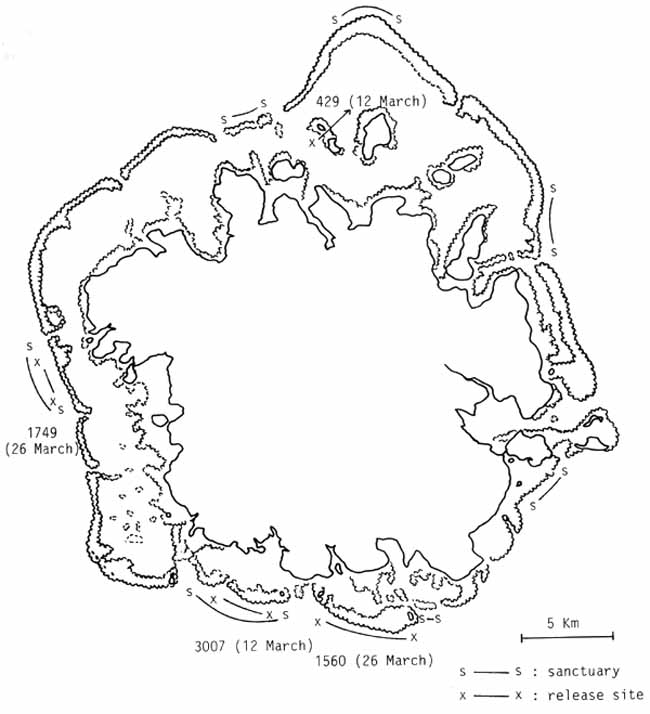The senior author noted abundant populations of an edible gastropod, Strombus luhuanus on reef flats of barrier reefs in Pohnpei. For example, ca. 100 shells were collected from an area of 2m × 2m on a reef flat near Kepara Island. Approximately 70 % of these were adults and the rest juveniles and subadults.
The personnel of Pohnpei State Marine Resources explained that this gastropod species was not used as food among the Pohnpeians probably because it was mistaken as a poisonous cone shell. However, Mr. Asher Edward, who was originated from the Pingelap Atoll, told us that they ate this species on his island.
The meat of S. luhuanus is highly prized by the people in the Ryukyus and the shell is used for ornamental material in souvenier trade. Such uses are common in the other areas such as Fiji, Papua New Guinea etc. Therefore, it was surprizing to find this important resource not being utilized on Pohnpei.
The following table indicated differences in shell sizes of S. luhuanus between islands of the Ryukyus and Pohnpei. This species stops growing in length after attaining adult morphology (determinate growth) so that only adults were compared in the table. The shell size of Pohnpei population in general was smaller than those of the Ryukyus.
Strombus luhuanus has been used as food throughout the Ryukyus, but has remained more or less as a resource for local subsistence, collected by reef gleening at low tides. However, in the recent years, commercial exploitation using air-breathing diving gears contributed to decline of this highly resilient (Catterall and Poiner, 1988) mollusc populations.
Table 4 Comparisons of shell lengths of Strombus luhuanus between Pohnpei population and those of islands in the Ryukyus
| locality | mean shell length | range | N |
| Pohnpei | 42.50 mm | 37.0 – 51.1 | 72 |
| The Ryukyus | |||
| Sekko, Amami Is. | 56.79 | 51.2 – 63.0 | 59 |
| Shiteku, Amami Is. | 53.39 | 46.1 – 63.1 | 140 |
| Sesoko, Okinawa Is. | 49.95 | 37.5 – 66.4 | 234 |
| Shinzato, Miyako Is. | 45.85 | 35.8 – 51.6 | 141 |
This species forms mating and spawning aggregations in shallow waters in Okinawa in winter. It is easy to destroy these populations by collecting such aggregations in subtidal zones before they could reproduce. In the past, people used to collect post-breeding animals when the daytime low tides revealed them in the intertidal zones only in spring and summer.
Gonads of the silver-mouth turban snails were examined by cutting their cross-sections at the posterior end of coiled caecum to reveal the extent of gonad development. Those gonads occupying ca. ⅓ or more of the diameters of cross-sections were considered to be ripe, those with only thin layers of gametes were designated as spent, and the rest either developing or partially spawned as intermediate.
Among the 42 specimens examined, there were 7 and 6 ripe females and males, respectively. Although 7 spent males were recognized, there were no spent females. The remaining 22 individuals (11 females and 11 males) were in very variable conditions between the ripe and spent conditions (Table 3). In short, gonad conditions were not uniform among the individuals from the northern barrier reef in Pohnpei.
According to Asano (1963), a total of 6,745 adult trochus were released at four areas by two shipments from Truk in March 1939. Shells were kept inside bail wells of a skipjack fishing boat and transported from Truk to Pohnpei in about two days and a half. Only 12 individuals (0.2 %) died out of 6,757 shells carried on board.
The seedstock shells were released along the lee (to the tradewind) sides of barrier reefs except for one area inside the lagoon (Fig. 5). There are seven trochus sanctuaries around the entire barrier reef system and two of them coinside with the release sites of transplantation.
It is evident that the site selection for the initial releases was correct and that the trochus has extended its range all around the barrier reef system from these localized (to lee side) release areas.
The total weight of live shells was estimated at about one metric ton when they were released in Pohnpei. This past investment resulted in sustainable yield of around one hundred ton per year, thanks to the efforts of the transplantation in the past.

Fig. 5 Trochus sanctuaries and release sites of 1939 transplantation in Pohnpei, indicating dates and numbers released.